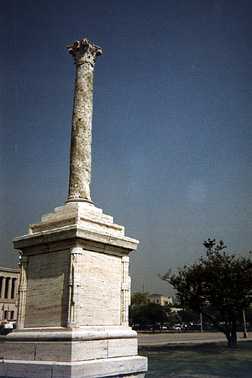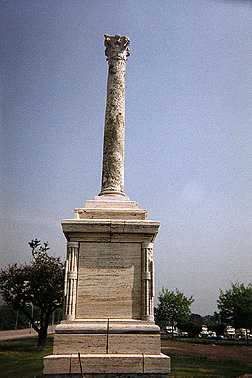A COLUMN FROM OSTIA IN CHICAGO
In 1959 Raissa Calza, widow of Guido Calza, wrote about a rectangular square or portico, c. 200 meters outside the Marine Gate, originally overlooking the sea. It had eight marble columns, one of which is missing, she tells us, because it was transported to the United States in the 1930's. It was a gift from Italy to the city of Chicago in remembrance of the first transatlantic crossing of the Italian airforce.
On June 30 1933, 25 sea-planes left Italy under the command of Italo Balbo, Mussolini's air marshal, who used mass flights as a propaganda tool. The planes left from Orbetello and flew via Amsterdam, Ireland, Iceland, Labrador and Montreal. They arrived in Chicago on July 15, and were welcomed by a huge crowd. The return flight began on July 25. The planes landed at Lido di Ostia on August 12.
The column formed part of the so-called "prospetto a mare" outside the Marine Gate, in front of the Building with Opus Sectile. In the periodical "Le vie d'Italia - rivista mensile del Touring club Italiano" is a photo of the column in its original setting. The caption says: "Il segno dell'amicizia fra l'Italia e la repubblica stellata" ("The sign of friendship between Italy and the starry republic"), and below the photo can be read: "La colonna degli scavi di Ostia che il Duce ha offerto alla città di Chicago e che verrà inalzata sulla riva del Michigan, a ricordo della trasvolata atlantica del decennale" ("The column from the excavations of Ostia that the Duce offered to the city of Chicago and that will be raised on the shore of Lake Michigan, in memory of the Atlantic crossing during the tenth anniversary [of the Royal Italian Air Force]"). Later Guglielmo Marconi, president of the "comitato Italiano" in Chicago, wrote a letter to Calza, thanking him for his collaboration in selecting the column.
 The arrival of Balbo in Lido di Ostia, August 12, 1933. |
 The photo from "Le vie d'Italia". |
The column must have reached the United States by boat. It was erected during the 1933-1934 World Exhibition, called "A Century of Progress". It was unveiled in front of the Italian pavillion, in 1934, after Balbo had left. The column still stands, but today in meaningless isolation. It is at a distance of a few meters from the shore of Lake Michigan in an area that is relatively unfrequented. It can be found in Burnham Park, at 1600 South Lake Shore Drive, just east of Soldier Field. It is generally called the "Balbo Monument". A midsized highway at a distance of some 600 meters from the column was in 1934 named Balbo Drive (until that time called 7th St.).

The unveiling of the column
The column was set up on a travertine base, with an inscription in Italian, describing it as a gift to Chicago from the people "dell'Italia fascista".


QUESTA COLONNA
DI VENTI SECOLI ANTICA
ERETTA SUL LIDO DI OSTIA
PORTO DI ROMA IMPERIALE
A VIGILARE LE FORTUNE E LE VITTORIE
DELLE TIREMI ROMANE
L'ITALIA FASCISTA SUSPICE BENITO MUSSOLINI
DONA A CHICAGO
ESALTAZIONE SIMBOLO RICORDO
DELLA SQUADRA ATLANTICA GUIDATA DA BALBO
CHE CON ROMANO ARDIMENTO TRASVOLO L'OCEANO
NELL' ANNO XI
DEL LITTORIO
THIS COLUMN
TWENTY CENTURIES OLD
ERECTED ON THE SHORES OF OSTIA
PORT OF IMPERIAL ROME
TO SAFEGUARD THE FORTUNES AND VICTORIES
OF THE ROMAN TRIREMES
FASCIST ITALY BY COMMAND OF BENITO MUSSOLINI
PRESENTS TO CHICAGO
EXALTATION SYMBOL MEMORIAL
OF THE ATLANTIC SQUADRON LED BY BALBO
THAT WITH ROMAN DARING FLEW ACROSS THE OCEAN
IN THE ELEVENTH YEAR
OF THE FASCIST ERA

On either side of the inscription are fasces. The inscription itself is a good example of Mussolini's attempts to use ancient Rome as an impressive forerunner of his own regime. Here we get the impression that the Atlantic Ocean has become part of the mare nostrum. It is interesting that the monument was not removed during World War II.
Sources: Arch. Mario Ietto, Italy; Barbara Cooper, Ostia (translation of inscription); Bill Thayer, Chicago; Giovanni Mulas, Scavi di Ostia; Marilyn Brusherd, Chicago; Tom Watkins, Department of History, Western Illinois University, Macomb; www.areacom.it; www.chicagohistory.org; Encyclopaedia Britannica; R. Calza - E. Nash, Ostia, Firenze 1959, p. 17; I.J. Back - M.L. Gray, A guide to Chicago's public sculpture, Chicago and London 1983; N. Mark, Norman Mark's Chicago, Chicago 1977.
Photos: the arrival of Balbo in Lido di Ostia: from G. de Nisi, Ostia - Lido di Roma, 1982, p. 79; the photo from "Le vie d'Italia" (anno XXXIX, n. 9, settembre 1933, anno XI era fascista, p. 720): provided by Giovanni Mulas; the unveiling of the column: from the archives of Guido Calza, provided by Mario Ietto; colour photos provided by Bill Thayer, © James Eason.